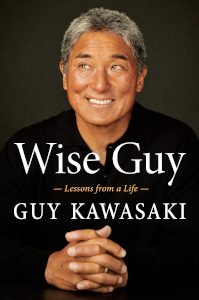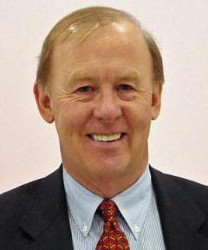Posted by Elena del Valle on March 28, 2019

Wise Guy by Guy Kawasaki
Photo: Guy Kawasaki
In his newest title Guy Kawasaki, author of 14 books, shares the insights he has learned over his lifetime. Wise Guy Lessons from a Life (Portfolio, Penguin, $28), a 246-page hardcover book, was published this year. It is divided into 11 chapters and begins with the emigration of the author’s grandparents to Hawaii.
When asked how long the project took to complete he replied by email, “It depends on how you want to look at it. From the time I decided to write the book until it was on the shelf was about eighteen months, but it took me sixty-four years to accumulate the wisdom to write the book. So the answer is between eighteen months and sixty four years.” And to a question about the audience for the book, he replied, “The primary audience is anyone with $20.”
“My publisher used the traditional methods of PR, ad buys, distribution through a salesforce, and social media,” the author replied to a question about promotion. “I used social media to recruit testers and reviewers; I spoke about it anywhere that I could; and I tapped my relationships with influencers. In general, we left very few stones unturned.”
The book is written in chronological and topical order. Kawasaki explains at the beginning of the book that he believes wisdom isn’t linear or quick. Each chapter includes a story and a section of what the author considers the lesson or wisdom to be gained. It is easy to identify as it is marked with a shaka or Hawaiian surfing hand symbol.
“My main goal was to empower people by telling them stories and then explaining the significance and wisdom underlying each story,” he replied when asked why he wrote the book. “This is not to say that every story in the book is a success story. I discuss many of my mistakes because they are highly educational. I hope, at least, that people will make different mistakes than the ones I made.”
When asked whether people can learn from anyone’s experiences he replied, “People can absolutely learn from the experiences of others. Otherwise 90 percent of books are a waste of trees and time. Are those people saying that they can’t learn that they should wear seat belts without being in a car accident?”
When asked if he is planning another book he replied, “I’ve written fifteen books. When I finished the first one, I told myself that I didn’t have any more books in me. I’ve now done that fifteen times. I don’t find topics. Topics find me. When the next topic finds me, I’ll write it.”

Click to buy Wise Guy: Lessons from a Life
Comments:
Filed Under: Books
Posted by Elena del Valle on March 20, 2019

Although the space is called Maison F.P. Journe the sign above the store reads F.P. Journe Invenit et fecit.
Photos: Kris Tamburello
Last month Francois Paul Journe and Pierre Halimi Lacharlotte opened Maison F.P. Journe, a watch boutique offering upscale liquor and Petrossian snacks, in
Miami (270 Biscayne Boulevard Way, Suite 101, Miami, Florida 33131, 305-993-4747, miami@fpjourne.com). The 3,200 square foot space will sell 15 Swiss watch models in different iterations. The shop has seating capacity for 42. It includes 10 bar seats and two lounges inside the boutique, as well as seating for 20 on the outside Terraza Astondoa, a cigar lounge. The exterior sign of the store reads: F.P. Journe Invenit et fecit. The last three words, according to a spokesperson, translate to “invented and made” from Latin, and is meant to certify that “each of the watches carrying FPJ’s name results from an entirely original conception with rigorous craftsmanship.”

The shop has seating capacity for 42.
The owners expect the shop to attract affluent people in Miami, liquor connoisseurs, watch aficionados, caviar fans and “anyone who enjoys an elevated bar and retail experience.” The space includes Bar Journe, an upscale bar that serves curated bites, Petrossian caviar and rare liquors. The outdoor lounge area outfitted by Spanish yacht-maker Astondoa is described as offering stunning views of Miami and cigars by La Flor Dominicana.

François-Paul Journe, co-owner, Maison F.P. Journe
A “fine and rare” collection includes about 24 antique and aged items. Watch prices range from $11,000 for the Electro Mechanical Elegante in 40 millimeters for ladies or men to 711,000 Swiss francs. Prices are offered in Swiss francs “because the price in USD is given at the time of purchase to accurately reflect the conversion,” according to a company spokesperson. One watch, the Tourbillon on a baguette set platinum case and bracelet, sells for $939,900.
Sample prices for liquor, spirits and wine include $8 for a beer, $55 for a 2 ounce serving of 1942 Don Julio Añejo on the rocks and $385 for a bottle of Cabernet Sauvignon. The caviar is from different farms around the world and prices range from $98 to $990. The shop sells three types of caviar, Royal Shassetra, Alberta President and Ossetra President, at 30 grams or 125 grams accompanied by yuca chips. There is also a suggested pairings for each caviar and a tasting menu priced at $485.
Posted by Elena del Valle on March 13, 2019
Branding Implications
By Jay Gronlund
President
The Pathfinder Group

Jay Gronlund, president, The Pathfinder Group
Photo: Jay Gronlund
We have heard a lot about Millennials (i.e., Generation Y), their impact on business, politics and society, and how different their values and practices are. Well, get ready for Generation Z. Their attitudes and actions are even more progressive and even more confounding to marketers. This Generation Z (born after 1996) is the best educated, most diverse and easily most open to emerging social trends of any prior generation. And their potential impact on commercial and political brands will be transformative. Click to read the entire article What To Expect From Generation Z
Posted by Elena del Valle on March 7, 2019

The Expanding News Desert Report
Photos: UNC Center for Innovation and Sustainability in Local Media
Many people believe balanced journalism provides us a sense of belonging to the place where we live and reinforces our trust in democracy. In the last decade it has become clear that newspapers and print media in general have had difficulty adapting their revenue model to the digital era. New generations seek news on social media and online via what have become the top online publishers, at least the ones with the highest revenue, leaving traditional media floundering in the winds of change. As a result in the United States increasingly our communities are losing access to local news. Cities and areas without local dailies or weeklies or with ghost versions of their former publications have been called news deserts.
In The Expanding News Desert (University of North Carolina Press, $12) Penelope Muse Abernathy, Knight chair in Journalism and Digital Media Economics University of North Carolina at Chapel Hill, discusses news deserts nationwide. The 102-page softcover book published in 2018 is divided into two main sections: The Loss of Local News: What it Means for Communities; and The Enduring Legacy of the New Media Barons: How Private Equity and Hedge Funds Changed Newspapers.
Since 2004 the United States has lost about 1,800 papers, including 60 dailies and 1,700 weeklies and California leads the nation in loss of dailies, while New York, Illinois and Texas lost the most weeklies, according to the book. Equally impactful to the rise of news deserts is the loss of readers. In the past 15 years, the book says, readers dropped to 73 million from 122 million. At the same time loss of competition has resulted in less coverage of local and state news, which studies have found often results in government inefficiency and increased costs, the book points out.

Penelope Abernathy, author, The Expanding News Desert Report
A troubling trend is the purchase of newspapers by investment companies who as a result become large and powerful controllers of news at a national scale. Their cost cutting and profit enhancing measures often have resulted in “ghost” papers, publications with too few resources to adequately cover their markets. The largest 25 companies of this ilk own 2, 198 papers. The largest of them is New Media/Gate House with 451 papers and a total circulation of 4.4 million. Others include Gannett with 216 papers, Digital First Media with 158, Adams Publishing Group with 144 and Community Newspaper Holdings, Inc. (CNHI) with 114.
The analysis in the book is based on information collected by the School of Media and Journalism at the University of North Carolina at Chapel Hill in the four years prior to the publication of the book. The researchers examined the status of more than 9,000 publications from data sourced from press association and governments as well as independent online research. It excludes the largest newspapers such as The New York Times, Wall Street Journal and USA Today as well as specialty publications. The book author invites readers to its partner website for local level specifics regarding news deserts.
Comments:
Filed Under: Books


















